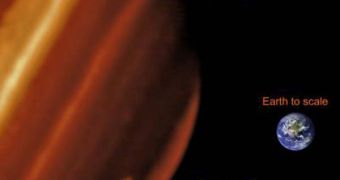The recent collision that scarred the face of Jupiter, and generated a cloud of debris comparable in size to a decent part of our planet, has again prompted astronomers to wonder what are the chances of our corner of the solar system being hit by a rogue object as well. The impact has reminded everyone that we are living in a dangerous system, and that it's always possible for other objects, traveling at ridiculously high speeds, to hit us or our neighbors in a moment's notice. At this point, astronomers are back to the drawing boards, seeking to uncover the probabilities of the Earth being hit sometime soon.
“If an object of about the same size that just hit Jupiter also hit Earth – it was probably a typical cometary object of a kilometer or so in size (0.6 miles) – it would have been fairly catastrophic,” NASA Near-Earth Object Program Office Manager, Astronomer Donald Yeomans says. The office is headquartered at the Jet Propulsion Laboratory (JPL), in Pasadena, California. At this point, more than 780 near-Earth objects (NEOs) have been discovered in our vicinity that are larger than one kilometer in diameter. Each of them has the ability to inflict significant and potentially fatal damage to our civilization, and, indeed, our planet as a whole.
However, there is the slight issue of getting to know all of the NEOs. Astronomers believe that there are at least 100 such objects lurking around, waiting to be discovered. And while, for the ones already found, the chances of an Earth impact are almost zero, the situation may be different for the others, or at least for one of them. Additionally, many hundred other large rocks are moving around our planet, though admittedly they are smaller than the one-kilometer threshold. Still, they are capable of inflicting severe damage, if they hit in certain critical spots.
Since the formation of the Earth, some 4.7 billion years ago, a large, half-mile object has stricken our planet once every 500,000 years or so. This accounts for several thousands of impacts since the early days, but the good news is that the next one is still some time away, Space reports. “For 500 meters (1,640 feet), we're talking a mean interval of about 100,000 years. When you get down to 50 meters, the mean interval is about 700 years, and for 30 meters (98 feet), about 140 years or so, but by then you're getting down to a size where you won't expect any ground damage, as they burn up in the atmosphere at about 25 meters (82 feet) in diameter and smaller, probably for an impressive fireball event,” Yeomans says.
There are, at this point, the scientist adds, at least four teams of astronomers around the world keeping an eye on NEOs of all shapes and sizes detectable. “We're concentrating on the large ones for now, but hopefully with the next generation of search, we'll be more efficient in finding the smaller objects, to find 90 percent of the total population of potential hazards larger than 140 meters,” the expert concludes.

 14 DAY TRIAL //
14 DAY TRIAL //